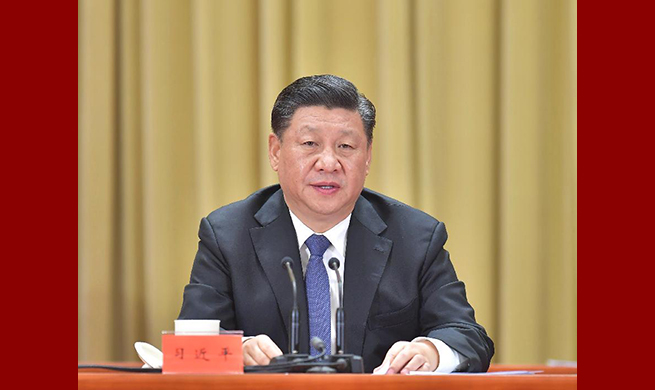by Pankaj Yadav, Jiang Lei
NEW DELHI, Jan. 4 (Xinhua) -- The recent electoral defeats of India's ruling Bharatiya Janata Party (BJP) has, more or less, left the party on back foot, experts said.
While it conceded three big states Madhya Pradesh, Chhattisgarh and Rajasthan, to the main opposition party the Indian National Congress (INC), it had a poor show in the rest of two states namely Telangana and Miroram, which were won by state-level political parties.
After its debacle in Bihar and Delhi in 2015, and Punjab in 2017, these were the most bitter defeats the BJP tasted ever since it assumed power at the center in May 2014.
Over the past four-and-a-half years of BJP's rule, almost all the states have went to polls. It convincingly won in 12 states, and formed governments in Indian-controlled Kashmir, Goa and Manipur, after forging alliances with smaller state-level parties but could not form a government in one state Karnataka which currently has a alliance government including the INC as a partner.
After the crucial losses the BJP suffered in December in three states to the INC, the battle for this year's general elections has become all the more exciting. INC president Rahul Gandhi seems to be elated and enthused after the political gains, which are credited to him by his party's ranks. The BJP's losses have been a net gain to the INC.
One of the major issues for the BJP's losses has been the farmers' woes. Last few months have witnessed protests by the farmers, who are demanding waiver of their loans and better support prices for the agriculture produce by the government. In all the three states where the BJP lost in December, the INC's new governments announced waiver of loans immediately after coming to power.
It seems farmers' issues, particularly their demand for loan waivers, are going to dominate the coming general elections. The election results have also proven the fact that the BJP is losing its sheen over the years, and can be defeated if the opposition parties forge formidable alliances.
Ever since the election results have been announced, both the BJP and the INC have pulled up their socks and preparing for the battle royale in 2019, forging pre-poll alliances and electoral understanding. Only a couple of days ago, the BJP yielded to one of its alliance partners Lok Janshakti Party's (LJP) demand giving it six constituencies in Bihar and promising one seat in the upper house, or the Rajya Sabha, to LJP chief and Union cabinet minister Ramvilas Paswan.
In the 2014 general parliamentary elections, the BJP had acquired a larger than life image after winning in a record number of 282 constituencies across the country, sweeping states like Gujarat, Rajasthan, Delhi, Chhattisgarh, Himachal Pradesh, Uttarakhand, Goa, Uttar Pradesh and Jharkhand, most of the states being in the north, or Hindi language-speaking states. They are popularly called as "Hindi heartland" in typical Indian political terminology.
However, in the by-elections during the past over four-and-a-half years of its rule, the BJP has managed to just retain its five constituencies which it had won in the 2014 polls, while it lost as many as seven to the main opposition the INC. by-elections are necessitated in case of death or resignation of a parliamentarian.
In 2014 the BJP had won as many as 282 Lok Sabha constituencies on its own, whereas its current tally has been reduced to around 268. This means over the past four-and-a-half years, the party lost 14 constituencies to opposition parties.
It is strongly believed that the BJP won't be able to repeat its performance in the 2019 general elections, as it had reached its zenith in the last polls. It's tally in the 'Hindi-heartland' is expected to decrease. And, the party, in a bid to make up the losses, is planning to trying its luck in eastern and north-eastern states, particularly West Bengal which has 42 parliamentary constituencies. The north-eastern states, popularly called as "seven sisters" have together around 25 parliamentary constituencies.
West Bengal is the only state in the country which has a women chief minister, Mamata Banerjee, a known bete noire of the BJP. The BJP has been politically attacking Mamata Banejee's rule. The party had won in just two parliamentary constituencies in the last elections, and wishes to increase its tally here seeing a vast scope as the state has 42 constituencies.
Politically biggest state Uttar Pradesh has 80 parliamentary constituencies and is currently ruled by a Hindu seer Yogi Adityanath who wears saffron robes. In the 2014 polls, the BJP had won a whopping 71 constituencies, the maximum a party won in the country's recent political history. However, during the past one year the BJP has been repeatedly suffering losses in the by-elections which shows that the party is facing anti-incumbency factor inside the state.
In the second most significant state of Maharashtra, which has 48 parliament constituencies, the BJP's long standing alliance partner Shiv Sena (SS) has been, of late, quite critical of Modi's policies, particularly in relation to farmers' issues. The alliance seems to be weakening day by day as the general elections approach. In 2014, the BJP had won 23 constituencies in the state out of the total 48.
The party has successfully forged a formidable alliance in the state of Bihar with the Janata Dal (United) which currently rules the state. The state has 40 Lok Sabha constituencies. The alliance is pitted against the one including INC and the Rashtriya Janata Dal (RJD), another strong state-level party which ruled the state for nearly 15 years since 1990.
The BJP has also shifted its focus on southern Indian states of Karnataka, Tamil Nadu, Puducherry, Kerala, Andhra Pradesh and Telangana, in a bid to increase its tally in parliamentary elections. In 2014, the party won only 22 constituencies in these states out of nearly 130. Like the northeast states combined with West Bengal, the BJP sees immense scope of increasing its headcount of lawmakers from these southern states.
On the other hand, the INC's electoral performance would depend on the alliances it is able to stitch with state level political parties, particularly in the "Hindi heartland" states namely Uttar Pradesh, Bihar, Jharkhand, Madhya Pradesh, Chhattisgarh, Haryana, Rajasthan. All these states share nearly 215 parliamentary constituencies.
Considering the recent hints dropped by regional political parties who could be INC's possible alliance partners, particularly the Samajwadi Party (SP) in Uttar Pradesh, stitching alliances would be a tough task as it would include conceding a specific number of constituencies to these state level political parties on their terms and conditions.













